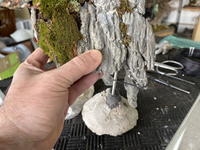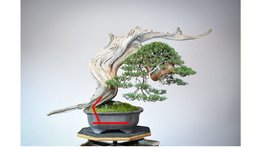IzzyG
Shohin
I'm linking the video that Bjorn made discussing the RMJ's journey prior to coming into my care. I'll give a cliff notes version since the the tree's time just prior to coming to Wisconsin impacted what has happened thus far.
-collected originally by Back Country Bonsai in 2015
-picked up by Bjorn for his new nursery in 2016
-initially styled in Dec 2017
-heavily pruned for Nationals in 2021
-scion grafted in early 2022
-all scions(2 out of 30 made it) failed through 2022 growing season
-restyled in early fall of 2022 before I picked it up
Prepared tree for Nationals in 2021:
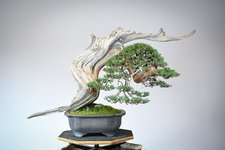
Restyled in early fall of 2022:
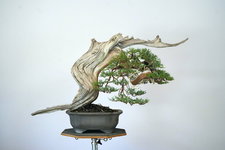
Arrival in Wisconsin:

After about a month of being in Wisconsin, I started seeing a couple of branches losing strength on the backside of the tree. I believe there was a bunch of factors that led to this(heavy pruning pre Nationals, failed grafts, restyling back-to-back) but nonetheless a decent sized branch that made up the body on the back side was lost(it was a branch that held 3-4 secondary branches that created the pads on the back side). I kept the branch over the winter just to stay optimistic but finally removed it this Spring. Fortunately, I was able to readjust a couple of branches to make up for the loss.
Weakening back branch:


One of the obvious issues that I also noticed when I picked the tree up was the lack of stability of the tree in the container. The base is actually pretty narrow and the manner in which it's anchored creates a sway on the entire tree when moved(you can see it move if there's a heavy wind too). The rather large piece of deadwood does not help this instability either so a plan to repot the tree was made in the winter(assuming it does well over winter) and I sought out a replacement container. My goal was three fold; reanchor and stabilize the tree in the pot, push the modern aesthetic of the tree(angular characteristics of the deadwood) even further and create the illusion of a stronger base(the current smaller container weakens the base imo). I played with a couple of ideas but ultimately decided on a Johnathan Cross container(photoshop to scale below)

However, as spring came into Wisconsin, I made the decision to remove that branch in the back side and questioned whether repotting would be appropriate or whether to wait a year to let the tree recover the crazy 2021-2022 years it had. Ryan(Neil) and Todd(Schlafer) had visited over winter/early spring for some work and I shared my concern. They both agreed that waiting another year wouldn't be a bad idea. Since it's really an up-pot in size, there wouldn't be any root work so we could also chance it. As the universe had it, the decision was made for me when the Johnathan Cross arrived damaged last week.
Damaged Johnathan Cross container:
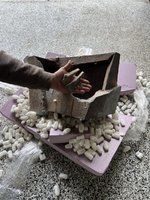
So recovery 2023 is now the plan and the RMJ has actually been showing robust growth throughout the whole foliage this early Spring. I'm hopeful of a strong growing season before a 2024 repot, then allow to recover and possibly a secondary styling in 2025. I'll keep updating this thread as it progresses throughout the year. The weather's been dreary this last week or I'd have an updated photo for y'all(I'll add one this next week as the weather is supposed to turn).

